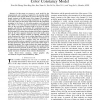Free Online Productivity Tools
i2Speak
i2Symbol
i2OCR
iTex2Img
iWeb2Print
iWeb2Shot
i2Type
iPdf2Split
iPdf2Merge
i2Bopomofo
i2Arabic
i2Style
i2Image
i2PDF
iLatex2Rtf
Sci2ools
TIP
2016
2016
A Retinal Mechanism Inspired Color Constancy Model
—In this paper, we propose a novel model for the computational color constancy, inspired by the amazing ability of the human vision system (HVS) to perceive the color of objects largely constant as the light source color changes. The proposed model imitates the color processing mechanisms in the specific level of the retina, the first stage of the HVS, from the adaptation emerging in the layers of cone photoreceptors and horizontal cells (HCs) to the color-opponent mechanism and disinhibition effect of the non-classical receptive field in the layer of retinal ganglion cells (RGCs). In particular, HC modulation provides a global color correction with cone-specific lateral gain control, and the following RGCs refine the processing with iterative adaptation until all the three opponent channels reach their stable states (i.e., obtain stable outputs). Instead of explicitly estimating the scene illuminant(s), such as most existing algorithms, our model directly removes the effect of ...
| Added | 11 Apr 2016 |
| Updated | 11 Apr 2016 |
| Type | Journal |
| Year | 2016 |
| Where | TIP |
| Authors | Xian-Shi Zhang, Shao-Bing Gao, Ruo-Xuan Li, Xin-Yu Du, Chao-Yi Li, Yong-Jie Li |
Comments (0)

